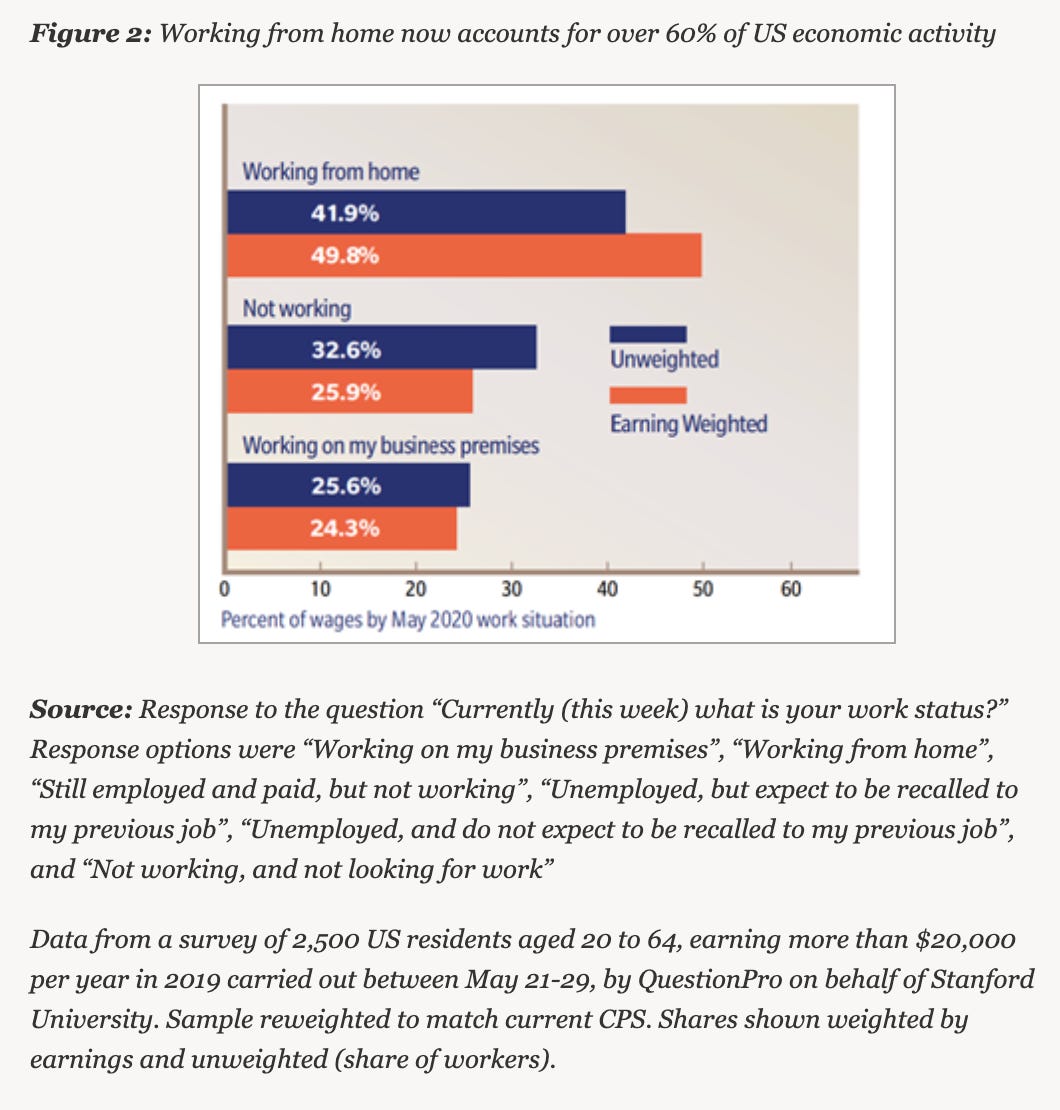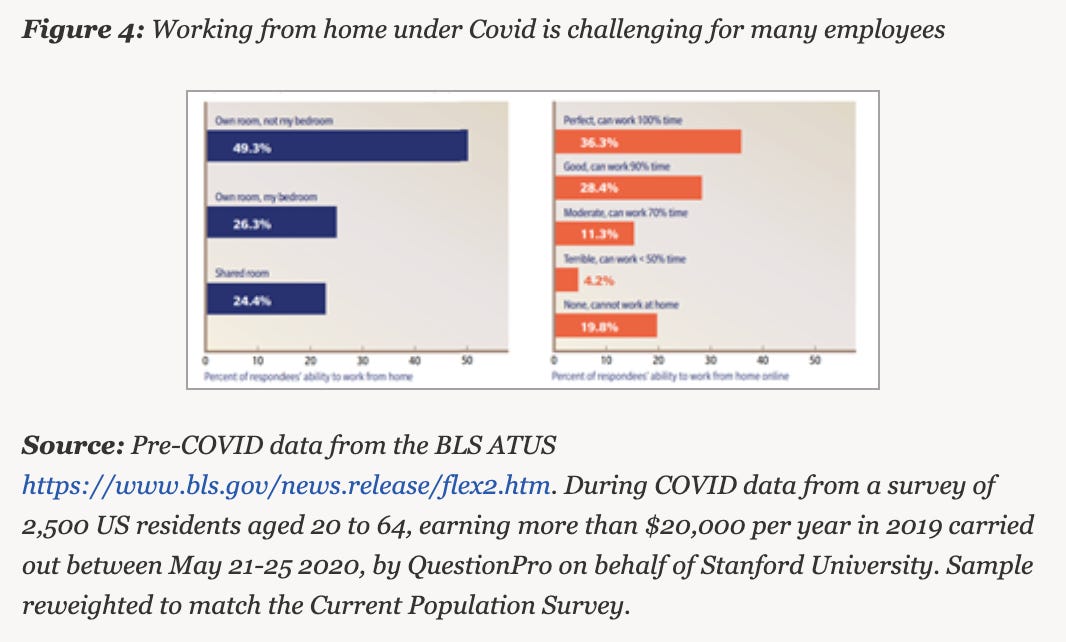How's Work From Home going?
For many people, surprisingly well with permanent change on the horizon.
Welcome to Plugging the Gap (my email newsletter mainly about Covid-19 and its economics). My goal is for several posts a week explaining economic research and the economic approach to understanding the pandemic. I may also deviate to other topics as well. (In case you don’t know me, I’m an economist and professor at the University of Toronto. I have written lots of books including most recently on Covid-19. You can follow me on twitter (@joshgans) or subscribe to this email newsletter at the link below).
Today is a data dump on what we have learned from the forced work from home ‘experiment’ Covid-19 has thrust on the world. The answer is: a lot. We are working longer and we have more meetings. What’s more, it portends future work habit changes that are likely to be permanent.
It is unlikely you are reading this email on your morning commute; unless of course, you count moving from the breakfast table to the couch as a commute. The first and most notable effect of Covid-19 was that those who could work from home worked from home. And, for the most part, that state of affairs is unchanged. As you sit in your confined surroundings wondering whether Zoom could offer something that looked like a watercooler, I figured you might like to know what’s happening more broadly in home offices (or whatever you choose to call an ‘office’) around the world.
Economist, Nicholas Bloom, who had studied work from home productivity even before it was forced on us, has some of the stats. Exhibit No.1 is that, in the US, 42% of the population is working from home. And they account for 60% of US economic activity. Is that a lot? Yes, that’s a lot. Pre-Covid, 85% of people never worked from home.

These are numbers likely not seen in 150 years when you could count working on a farm as working from home. They are, of course, the lucky ones as unprecedented numbers of people are no longer working at all.
And how are they doing at that? Here is Exhibit No.2.

Actually, this is surprisingly well. Given that most people took great pains to get into the office every day, you would have thought very few would still feel they could do their jobs well. This good performance is something I have heard from business leaders who are now looking at the real estate holdings and wondering if they will be necessary again. Seen in this light, work from home was a big forced experiment that people thought too costly to try pre-Covid. Its seeming success should make us predict that some of those changes may be permanent.
That said, it isn’t great for everyone.

But you should read that as an opportunity. That people seem to be productive without having optimised their home for long periods of work from home means there is opportunity for improvements. In other words, we should expect that if this becomes a thing, it will become a better thing than what we have seen during its first four months.
There is more. Working from home is great if you are richer and not so great if you are poorer. It also drew people out for city centres — which was the intent — but if you happen to operate businesses in those city centres serving working people, that’s going to be a problem.
But Bloom is sanguine. After all, we used to have people come to work partly because it was hard to evaluate their work when they weren’t there.
For remote working to succeed, it is essential to have an effective performance review system. If you can evaluate employees based on output - what they achieve - they can easily work from home. If they are effective and productive, great; if not, warn them; and if they continue to underperform, haul them back to the office. This approach requires effective performance management. In firms which do not have effective employee appraisal systems management, I would caution against WFH. This was the lesson of Yahoo in 2013. When Marissa Meyer took over, she found there was no effective employee evaluation system, so working from home was paused while she revamped performance reviewal mechanisms.
In other words, what we are seeing now is all well and good. But what precisely this evolves into is another matter.
Working Together
Employee monitoring aside, the other reason we used to go to work was so we could work together. What has Covid-19 done to that?
A team of researchers, Evan DeFilippis, Stephen Michael Impink, Madison Singell, Jeffrey T. Polzer, and Raffaella Sadun, the very existence of which suggests that collaboration is still possible during Covid-19, has taken a close look at this across 16 metro-regions across the world using email data from 3 million plus people. Now you might look at your daily list of Zoom meetings and think, well I am pretty sure I am meeting colleagues as much as ever. And it turns out you are not alone. They find:
increases in the number of meetings per person (+12.9 percent)
increases in the number of attendees per meeting (+13.5 percent),
decreases in the average length of meetings (-20.1 percent).
a net effect is that people spent less time in meetings per day (-11.5 percent) in the post- lockdown period.
So you have lots of meetings but they take less time. You had me at less time!
That said, you are working more. Overall workdays are 8% or 48 minutes longer on average. But my guess is that some of that is coming from your very short commutes.
In summary, the way in which this has all gone down should give us pause regarding whatever we were doing pre-Covid and whether it did and certainly still makes sense. But it goes without saying that it is one thing to work from home during a crisis. What happens when there are choices? It is hard to say but I do know that it will be great fodder for management researchers in the years to come.
What did I miss?
August: Assigning blame for Covid-19
August: Together by a Tether
August: Cities and Covid Reopening
July: That DisneyWorld Reopening: An Opportunity Lost?
July: Will a Covid-19 vaccine exacerbate the economic downturn?

